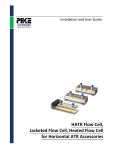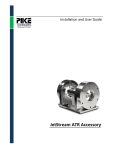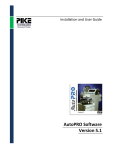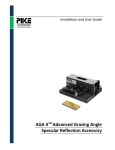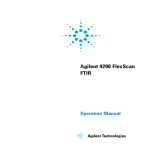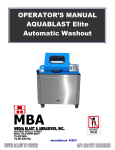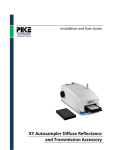Download 350-025002 Miracle generic.pmd
Transcript
Installation and User Guide MIRacle ATR TM for FTIR Spectrometers The information in this publication is provided for reference only. All information contained in this publication is believed to be correct and complete. PIKE Technologies Inc. shall not be liable for errors contained herein nor for incidental or consequential damages in connection with the furnishing, performance, or use of this material. All product specifications, as well as the information contained in this publication, are subject to change without notice. This publication may contain or reference information and products protected by copyrights or patents and does not convey any license under the patent rights of PIKE Technologies, Inc. nor the rights of others. PIKE Technologies Inc. does not assume any liability arising out of any infringements of patents or other rights of third parties. This document contains confidential or proprietary information of PIKE Technologies, Inc. Neither this document nor the information herein is to be reproduced, distributed, used or disclosed, either in whole or in part, except as specifically authorized by PIKE Technologies, Inc., PIKE Technologies, Inc. makes no warranty of any kind with regard to this material including, but not limited to, the implied warranties of merchantability and fitness for a particular purpose. Copyright 1991-2006 by PIKE Technologies, Inc., Madison, WI 53719. Printed in the United States of America. All world rights reserved. No part of this publication may be stored in a retrieval system, transmitted, or reproduced in any way, including but not limited to, photocopy, photograph, magnetic or other record, without the prior written permission of PIKE Technologies, Inc. Address Comments to: PIKE Technologies, Inc. 2901 Commerce Park Drive Madison, WI 53719 Phone Fax E-mail Web Site (608) 274-2721 (608) 274-0103 [email protected] www.piketech.com Part Number Release 350-025004 September 2006 CONTENTS INTRODUCTION ............................................................................................................. 4 UNPACKING YOUR ACCESSORY ............................................................................... 6 Packing List, MIRacle ATR Accessory ................................................................................................................... 6 Packing List, MIRacle Pressure Clamp, Universal Plate Options ......................................................................... 7 INSTALLATION .............................................................................................................. 8 Accessory Adjustment .............................................................................................................................................. 8 Performance Verification ........................................................................................................................................ 9 SAMPLING PROCEDURES......................................................................................... 10 Liquid Sampling Configuration ............................................................................................................................. 10 Solid Sampling Configuration ............................................................................................................................... 11 Pressure Clamp Tip Attachments .......................................................................................................................... 11 Pressure Clamp Installation and Operation .......................................................................................................... 12 Volatiles Cover ....................................................................................................................................................... 15 Configuration for Powder Sampling ...................................................................................................................... 15 Crystal Cleaning .................................................................................................................................................... 16 Effects of Temperature ........................................................................................................................................... 16 ATR SPECTRA ............................................................................................................. 16 ATR Correction ...................................................................................................................................................... 17 Liquids .................................................................................................................................................................... 18 Solids ...................................................................................................................................................................... 19 USEFUL EQUATIONS ................................................................................................. 20 Depth of Penetration ............................................................................................................................................... 20 MATERIALS .................................................................................................................. 20 Zinc Selenide .......................................................................................................................................................... 21 AMTIR .................................................................................................................................................................... 21 Germanium ............................................................................................................................................................. 21 Silicon .................................................................................................................................................................... 21 Diamond .................................................................................................................................................................. 21 PRECAUTIONS ............................................................................................................ 22 MIRRORS ..................................................................................................................... 22 SAFETY ........................................................................................................................ 22 MAINTENANCE/REPLACEMENT PARTS LIST ......................................................... 23 MIRacle Accessory User Guide Page 3 INTRODUCTION MIRacleTM is the PIKE Technologies patented Universal Sampling Accessory Family designed for Single or Multi-Reflection Horizontal ATR (HATR) and Specular Reflectance measurements with FTIR spectrometers. The accessory features a unique optical design (US.PAT: 5,965,889 and 6,128,075), which provides exceptional sensitivity and IR throughput. The single reflection sampling plate of the accessory has a 1.8 mm round crystal surface allowing reliable analysis of small samples. Solid materials can be put in good physical contact with the sampling area through high pressure clamping, yielding high quality, reproducible spectra. ATR crystal plates come in several configurations, including ZnSe, AMTIR, Ge, Si or Diamond. The first three options are suitable for analysis of liquids, semi-liquid materials and pliable solids. The Si or diamond configurations should be used when working with reactive samples and/or abrasive solid materials which need to be pressed hard against the crystal. Singlereflection ATR works very well for the analysis of relatively strong absorbing substances (e.g. polymers, rubber, paint chips, fibers, etc.). Highly absorbing samples, such as black rubber are best analyzed using the Ge plate due to it’s lower depth of penetration. Acidic samples are best handled with AMTIR, Ge, Si or Diamond crystal plates. For samples with relatively lower absorption characteristics or when trace elements are present, the new 3 reflection plates are also available in most crystal materials. Also, the MIRacle specular reflectance plate provides for even more flexibility for doing 45 degree specular reflectance work without the need to change the accessory base. The compact design of the accessory employs a transfer mirror to direct the infrared beam to one end of an IR transmitting ATR crystal (or specular reflectance reflectance mirrors). A second mirror directs the beam emitted from the other end of the MIRacle plate to the detector built into your FTIR spectrometer. The MIRacle features a universal sampling plate design which eliminates the need for separate trough and flat plates, such as normally in HATR for handling liquid and solid samples, respectively. The accessory can be equipped with a wide choice of compression clamps, including micrometer controlled, high pressure, rotating high pressure, digital readout high pressure and viewer high pressure clamp. Included as standard are the base optics assembly with baseplate and purge tubes specific to your FTIR spectrometer model, trough plate insert, mounting ring, volatiles cover, purge tubing attachments and adjustment wrench set. Add to this your choice of MIRacle universal plate(s) and pressure clamp(s), all of which are easily interchangeable. MIRacle Accessory User Guide Page 4 Sample clamp with micrometer controlled spring tension (other clamps also available) Clamp position control knob Mounting ring Teflon liquid holder Liquid plate (trough) insert Sampling area Universal ATR plate Base assembly Exploded view of the MIRacle, Single Reflection Horizontal ATR Accessory MIRacle Accessory User Guide Page 5 UNPACKING YOUR ACCESSORY In order for you to quickly verify receipt of your accessory, we have included a packing list. Please inspect the package carefully. Call PIKE immediately if any discrepancies are found. PACKING LIST MIRacle ATR Accessory MIRacle Base Optics Assembly* Purge Tubes*, 2 each Mounting Ring & Trough Insert* Volatiles Cover** Purge Tubing kit w/connector** Alignment Wrench Set** * The MIRacle base optics assembly has the Universal Plate, purge tubes, trough insert and mounting ring attached to the base when purchased with a Universal ATR Plate. Some base optics assemblies may appear different (such as adjustment screw locations and mounting scheme) ** The purge tubing kit, wrench set, volatiles cover, pressure Clamp and tips (when ordered) are packed separately in the carrying case. The purge tubing kit is not needed with some models equipped with recognition bases. The Swivel Tip is attached to the Sample Clamp assembly MIRacle Accessory User Guide Page 6 PACKING LIST (CON’T) MIRacle Pressure Clamp Options MIRacle Micrometer Pressure Clamp MIRacle High Pressure Clamp MIRacle Rotating High Pressure Clamp MIRacle Digital Readout High Pressure Clamp MIRacle Viewer Pressure Clamp Pressure Tips: Swivel Tip, Concave Tip, Flat Tip;1 Each Note: Tip of swivel tips for Micrometer clamp and 3 reflection plates are made of (white) plastic; Swivel tip for High Pressure clamps are Stainless Steel. Depending on specific clamp, the pressure tips may appear different than the picture. MIRacle Universal Plate Options Single Reflection ATR Plate MIRacle Accessory User Guide 3 Reflection ATR Plate (includes 5mm swivel tip) Specular Reflection Plate Page 7 INSTALLATION The MIRacle accessory has been aligned and tested in the PIKE Technologies facility to ensure that it performs to specifications. However, some variation in optical alignment can occur from spectrometer to spectrometer. To allow for this difference, there are four alignment screws provided on the MIRacle base optics assembly for fine-tuning, once the accessory is installed in the spectrometer. The following is the procedure for accessory installation and final alignment. 1. 2. 3. The MIRacle accessory fits into the sample compartment of the FTIR spectrometer. Your MIRacle is provided with the appropriate sample compartment baseplate for the model FTIR instrument you specified. Before inserting the accessory in the sample compartment, ensure that your spectrometer is aligned. If the instrument is not aligned, maximize the interferogram signal (the IR energy throughput) of your FTIR spectrometer. This should be performed by following the manufacturer’s instructions. When this has been done, collect a single beam background spectrum. In order to locate the accessory in the correct position, simply place the entire accessory into the FTIR sample compartment with the PIKE MIRacle label facing the front and line up the baseplate provided with the holes/pins in your model FTIR Spectrometer. Fasten the accessory onto the FTIR sample compartment baseplate using the captive screw(s) located on the MIRacle baseplate (some accessories may have two mounting screws or a mounting screw/pin combination, depending on spectrometer configuration). Tighten the captive mounting screw (with flat head screwdriver or by hand) to firmly position the accessory baseplate onto the FTIR sample compartment baseplate. The MIRacle accessory is now ready for optical alignment. Accessory Adjustment The MIRacle accessory may not require any alignment when installed. However, should you choose to fine-tune the accessory, follow these steps: 1. Display the live interferogram on the spectrometer monitor and using the thumb screw on the left side of the accessory, adjust the left mirror until the highest throughput is achieved. To do this, turn the screw slightly clockwise and check the signal. If it increases, continue until the maximum is obtained. If it decreases turn the screw counterclockwise to get the highest possible reading. 2. Repeat the same procedure with the right thumb screw. 3. Insert the enclosed allen wrench in the front adjustment screw on the top of the accessory. Adjust the screw until the highest throughput is obtained. 4. Repeat the same alignment step with the rear screw positioned on the top plate. 5. Repeat the entire procedure 2-3 times to fine-tune the accessory. Note: For some side focus FTIR models, both thumb screws are located on the right side of the MIRacle base optics assembly. MIRacle Accessory User Guide Page 8 This is an initial (one-time) alignment procedure which optimizes the MIRacle to work with an individual optical bench. Once completed, the alignment does not have to be repeated, unless the accessory adjustments have been moved or it has been placed in a different FTIR instrument. You are now ready to verify the MIRacle optical throughput performance. PERFORMANCE VERIFICATION • With the accessory removed from the sample compartment, collect a background spectrum (as mentioned in step 1 of the installation instruction on page 8). • Place the MIRacle accessory in the instrument per steps 1, 2 and 3 of the installation instruction on page 8. • Collect a transmission spectrum using the same collection parameters as used to collect the background spectrum. The following are the % transmission values the accessory should achieve with different crystal configurations at 1000 cm-1 (with the exception of the Si value which is shown at 2000 cm-1 ). ZnSe single reflection ATR plate: AMTIR single reflection ATR plate: Ge single reflection ATR plate: Diamond w/ZnSe lens single reflection ATR plate: Diamond w/KRS-5 lens single reflection ATR plate: Si w/ZnSe lens single reflection ATR plate: ZnSe 3 reflection ATR plate: AMTIR 3 reflection ATR plate: Diamond w/ZnSe lens 3 reflection ATR plate: Specular Reflectance plate: Greater than 22%T Greater than 22%T Greater than 25%T Greater than 25%T Greater than 22%T Greater than 22%T Greater than 12%T Greater than 12%T Greater than 12%T Greater than 20%T If your accessory does not meet this minimum transmission level, please contact PIKE Technologies. Before making this call, please record the serial number located on the label on the back of the MIRacle base optics assembly. Note: IR throughput performance of your accessory will decrease slowly over time as the lens surface is exposed to the environment and due to normal wear from cleaning the ATR surface. Contact PIKE Technologies for information about MIRacle Universal Plate refurbishment services when transmission throughput drops below a usable level. MIRacle Accessory User Guide Page 9 SAMPLING PROCEDURES The spectrum of the required sample is obtained by ratioing a scan with a sample in place to a scan with no sample on the face of the crystal. The crystal mount is located on the base unit. A single crystal design is used for all types of samples (liquids, pastes, soft pliable films and solids). Configuration for Liquid Sampling Note: The MIRacle accessory is typically shipped in a liquid sampling configuration with trough insert installed. Remove the mounting ring and trough insert plate before running solid samples. The crystal plate assembly of the MIRacle single reflection ATR features a round plate design, with a 1.8 mm sampling area, located in the center (6.0 mm for 3 reflection plates). The side of the crystal plate features coarse threads provided for mounting various attachments. For liquid sampling, a trough insert is placed on the top of the plate and fastened with the knurled mounting ring. The insert forms a shallow well around the crystal for containment of liquid and finely powdered samples. The sample must be in intimate contact with the sampling area for the ATR evanescent wave to provide the highest signal. For routine sampling, place a drop of your sample in the trough insert and collect data. Care is required when removing the sample from the trough. It is desired that the sample be removed without scratching the surface of the crystal. Note that some crystals used in the accessory are made of fairly brittle materials (such as ZnSe, Si, Ge or AMTIR). Scratches on the surface of the crystal will result in a reduction in the throughput of the accessory. Remove the sample gently with a non-abrasive cotton tissue and rinse with solvent. For more thorough cleaning, unscrew the mounting ring and remove the insert. Both, the insert and the crystal plate should be cleaned with an appropriate mild solvent, such as Isopropyl alcohol or a stronger solvent, such as Acetone. Cotton swabs are highly recommended for ease of cleaning without scratching the soft ATR surface. Sometimes “carry over” may occur from one sample to another due to incomplete cleaning of a prior sample from the face of the crystal. This effect may be minimized by washing the trough with the new sample, cleaning the crystal and then running a background scan. The sample is then placed on the crystal again and a sample spectrum collected. Samples should not be left in contact with the crystal for an extended period of time since some samples may degrade the crystal material and discoloration of the metal plate can occur. Once the measurement has been made, remove the sample from the crystal and clean the surface of the crystal and the surrounding plate area with a suitable solvent. Note that the PIKE high pressure clamps have the ability to swing sideways for ease of accessing the crystal surface for cleaning. Also, the rotating high pressure clamp has the ability to rotate the pressure tip to face upwards for ease of cleaning the tip between samples. MIRacle Accessory User Guide Page 10 Configuration for Solid Sampling For measurements of soft pliable films and selected solid samples, the mounting ring and liquid trough insert should be removed from the crystal plate assembly. The sample is placed onto the surface of the crystal. Since the ATR effect only takes place very close to the surface of the crystal, an intimate contact has to be made by the sample on the ATR crystal surface. This is achieved by using the pressure clamp(s) ordered with your MIRacle system. Mount the pressure clamp to the back side of the accessory using the two alignment dowel pins on top of the MIRacle base and fasten using the two captive thumbscrews on the clamp frame. With the sample in place on the crystal, lower the pressure tip so that it is in contact with the sample. With the micrometer clamp or digital readout high pressure clamp, it is possible to achieve reproducible sampling by applying the same amount of pressure to your samples. This is done by using the same settings on the micrometer screw or by using the electronic digital display, respectively. However, in most cases, it is recommended to apply the maximum pressure allowed to ensure the best contact and highest sampling sensitivity. The maximum force applied by the micrometer pressure clamp is 10 pounds (>2500 psi). The maximum force applied by the high pressure clamps is 40 pounds (>10,000 psi). The high pressure clamps have the additional advantage of a slip clutch mechanism to avoid over tightening. Caution: Care must be used in operating the pressure clamps, since the pressure device may slide the sample over the crystal. If the sample contains grit or abrasive materials, the surface of the crystal may be damaged by the sample motion while pressure is being applied. Ensure that the sample remains stationary while applying load to the clamp. In addition, softer ATR materials, such as ZnSe, need to be handled with care when running hard or sharp sample types. Do not apply the maximum pressure to these types of samples on softer ATR plates to avoid cracking, denting or scratching. Pressure Clamp Tip Attachments The success of an ATR measurement depends mostly on the quality of the contact between the sample and the crystal. Since there is an infinite number of sample shapes and types, a single configuration of the sample press tip may not be adaquate. For this reason, the MIRacle pressure clamps are designed to accept three different tip attachments, providing the best possible configuration for any given sample type. In addition, the 3 reflection ATR plates are provided with a special plastic swivel tip matching it’s 6 mm diameter crystal size. The accessory is shipped with the swivel tip attached to the pressure clamp ordered with the MIRacle accessory. This tip features an end cap mounted onto a small ball joint. Such design allows the pressure tip to move and adjust its position to the shape of the sample and maintain the sample position parallel to the crystal surface. This tip allows for better positioning and optimal contact of thin materials with the crystal MIRacle Accessory User Guide Page 11 surface. The swivel tip is used with irregularly shaped samples, films, semi-rigid polymers (e.g. credit card like materials). It can also be used for special applications, including analysis of single fibers and combinatorial chemistry beads. When using a plastic pressure tip, it is important to prevent its direct placement on the crystal, as its spectrum would interfere with that of the sample. This is not a problem when dealing with a majority of samples. For small samples that do not cover the crystal when pressed by the tip, such as beads, powders or fibers, a small piece of aluminum foil should be placed between the tip and the sample to eliminate such exposure. The flat tip attachment is a straight metal barrel and it is used when analyzing rubber samples and other elastic polymers. This tip should not be used for analysis of thin films or fibers, as it may not position the sample perfectly on the crystal surface (the swivel tip described above is designed to perform such a function). Please keep in mind that the depth of penetration of an ATR crystal is only in the range of 0.5 to 2 micrometers and even a small departure from intimate contact with the crystal will affect the magnitude of the sample absorption. The concave tip was developed specifically to work with granules, large beads and polymer pellets. The tip features a concaved surface which does not allow the sample to escape from underneath the press. It also forces the sample to stay in the center of the crystal, assuring the best possible contact. PRESSURE TIPS: swivel tip flat tip concave tip Micrometer Pressure Clamp The micrometer clamp assembly consists of the base which attaches directly to the accessory top plate and the “r” shaped arm with control knobs for raising and lowering the sample press. The clamp itself, is a stainless steel barrel with the integrated micrometer screw at the top and the spring-loaded plunger at the bottom. A spring is located between the shaft of the micrometer screw and the plunger. The spring tension can be adjusted by changing the position of the micrometer screw. This adjustment allows application of higher or lower pressure to the sample placed on the accessory’s sampling plate. MIRacle Accessory User Guide Page 12 The numbers on the scale of the micrometer screw serve as reference (they do not indicate the actual pressure applied to the sample)*. The actual pressure per square inch (PSI) depends on the size of the tip attached to the press and the spring tension. Listed below are the approximate pressures calculated for the square edge stainless steel tip (diameter 0.125”). Micrometer Setting 3.0 2.0 1.0 0.0 Pressure (psi) 408 530 693 815 The lighter pressures should be used for soft, flexible samples. The higher pressures are necessary for hard polymers, bids, granules, etc. (Please see also the note on selection of pressure clamp tips). The following is a short procedure outlining proper use of the MIRacle micrometer controlled sample clamp (025-3050): 1. 2. 3. 4. 5. Select the appropriate tip and attach it to the press. Position the sample on the accessory plate. Set the micrometer screw to 2.0. Lower the press barrel with the control knobs, until the edge of the sampling tip touches the lower brass end of the barrel. Collect the sample spectrum. Some FTIR spectrometers offer “real-time” data collection modes (names like MONITOR, DATA PREVIEW, EXPERIMENT SETUP, etc. are used for their description). If available, you can experimentally determine the best pressure for your particular sample by observing the shape of the spectrum while adjusting the micrometer screw. * Please note that the spring in the clamp assembly is not compressed until the micrometer screw is set to 3.5. For this reason, always keep the micrometer setting between 3.5 and 0. High Pressure Clamps The high pressure clamps consist of the base which attaches directly to the accessory’s top plate, the stainless steel pressure tip arm and the pressure control knob with built in slip-clutch mechanism. A removable anvil is located underneath the pressure module. This anvil is positioned in the center of the crystal plate and provides direct pressure to the sample. The pressure clamp module rides up and down on a lead screw located in the clamp column, with its position adjusted by the control knob. The control knob features a rachet-type clutch mechanism that controls the maximum allowable pressure and protects the crystal from over tightening. PIKE offer 4 versions of this style clamp. MIRacle Accessory User Guide Page 13 High Pressure Clamp Installation 1. Position the clamp on the two dowel pins located on the top plate of the MIRacle accessory. Please note that the top plate extends approximately 1/4” beyond the MIRacle base. The clamp mount provides a space to accommodate for this extension. Before the clamp can be fully mounted on the pins, the plate extension and the groove in the clamp mount must be perfectly aligned. 2. Press the clamp down until the pins fully engage. Using a flat head screwdriver, tighten the captive screws so the clamp is firmly attached to the accessory base. 3. For Digital readout clamp only: Flip the switch on the top of the clamp to “ON” position. The digital display located on the beveled surface of the pressure module should display “000”. The numbers displayed on the digital readout should be treated as arbitrary unit reference points, as they do not indicate the actual pressure applied to the sample. The actual pressure per square inch (PSI) depends on the size of the tip attached to the press. The direct pressure applied at the maximum compression point is approximately 40 pounds. The lighter pressures should be used for soft, flexible samples. The higher pressures are necessary for hard polymers, beads, granules, etc. 4. As with the micrometer pressure clamp, the high pressure clamps are provided with three pressure tips; swivel, flat and concave. However, the swivel tip for the high pressure clamps is made of metal vs. white plastic due to the higher clamping forces involved. 5. The clamp is now ready for use. The diagram below shows how the high pressure clamp models are able to swing to the side for ease of cleaning. It also identifies the slip clutch knob used for applying pressure to the sample without over tightening. A detent holds the pressure clamp tip in place directly over the crystal. Pressure Control Knob Display Battery Location Display On/Off Switch Digital Readout Pressure Display Digital, High Pressure Clamp rotated for easy access to the crystal plate MIRacle Accessory User Guide Page 14 Viewer Clamp Installation The MIRacle Viewer operates with the standard high pressure clamp assembly. The Viewer helps position small samples centered on the small ATR crystal. To operate, place the sample on the crystal surface and lower the clamp using the control knob until the sapphire window makes contact with the sample. To make small adjustments to the sample position, loosen the control knob slightly, re-position the sample and re-tighten the control knob. For best viewing of the sample area, look through the lens on the top of the Viewer positioning your eye 2-10 inches away. The sample area is illuminated through the lens by ambient light, so do not block the natural room light from the Viewer eye piece. The sharpest image can be obtained when the sample is in contact with the window. Sample Analysis with High Pressure Clamps 1. Select the appropriate pressure tip and attach it to the clamp’s pressure tip arm (see tip descriptions and their recommended use on page 11 and 12). 2. Position the sample on the accessory sampling plate. 3. Lower the pressure module with the control knob(turning clockwise) until the desired pressure is achieved. 5. Collect the sample spectrum. Caution : MIRacle ATR universal plates damaged by excessive pressure cannot be covered by the warranty. Extreme caution is required when using the high pressure clamps with ZnSe, Ge, AMTIR and Si crystal ATR universal plates. In addition, the diamond component utilized in this accessory is only 0.5 mm thick. This crystal will withstand higher pressures than traditional IR materials, but it still may be damaged by an excessive force. For this reason, do not exceed the pressure originally set by the factory on the high pressure clamps. In addition, maximum pressure (10,000 psi) should only be used when the sample makes contact with the entire 1.8mm dia. surface area of the ATR. Volatiles Cover A cover is provided to place over the sample when volatile liquids are being analyzed. This reduces the amount of evaporation of the sample on the surface of the crystal. Configuration for Powder Sampling With care, most powders may be analyzed with an ATR accessory. Note that since the ATR effect requires the sample to be in intimate contact with the crystal, this method is most effective when analyzing soft powders. Configure the MIRacle accessory for liquid sampling by installing the trough insert, holding it down with the knurled mounting ring. MIRacle Accessory User Guide Page 15 Mount the clamp using the two captive thumbscrews. Powders may now be placed in the trough and pressed into contact using the press. Note that hard/abrasive powders should be analyzed only with diamond ATR to avoid scratches/damage to the surface of softer crystal materials. Often, the trough insert and mounting ring are not required. In some cases, diffuse reflectance is the preferred technique for powder analysis. Crystal Cleaning The solvent used for cleaning your crystal is dependent on the sample that has been analyzed. In all cases it is best to attempt to clean the crystal with the mildest solvent possible. For most cases, the preferred solvent is isopropyl alcohol. If a stronger solvent is required, acetone may be used. In very stubborn cases dimethylformamide may be used. In all cases when using solvents, inspect the materials safety data sheet associated with the solvent you are using and comply with any recommended handling procedures. Apply the solvent to the crystal with a Q-tip and gently remove using a Q-tip or non-abrasive wipe. Repeat this procedure until all traces of the sample have been removed. Under no circumstances should the softer crystal materials (ZnSe, AMTIR, Ge) be rubbed with paper products such as “Kleenex” or “Kimwipes”. Many paper products are abrasive and could cause scratching of the softer crystal surfaces. Effects of Temperature The PIKE Technologies MIRacle utilizes an indium gasket to seal the crystal to its mount. This sealing mechanism allows some flexibility and hot samples may be placed on the crystal without damaging the crystal or seal. However, it is recommended that the temperature difference between the sample and the crystal be not more that 30 degree Celsius. So for a crystal at room temperature, the sample may be at a temperature of up to 50 degrees Celsius. Please contact PIKE Technologies if you wish to place samples of a higher temperature on the crystal surface. Heated MIRacle plates are also available and can be heated up to 120C (60C for Diamond). ATR SPECTRA ATR spectra are similar to transmission spectra. A careful comparison of ATR spectra and transmission spectra reveals that the intensities of the spectral features in an ATR spectrum are of lower absorbance than the corresponding features in a transmission spectrum and especially in the high wavenumber (short wavelength) region of the spectrum. The intensity of the ATR spectrum is related to the penetration depth of the evanescent wave into the sample. This depth is dependent on the refractive index of the crystal and the sample, and upon the wavelength of the IR radiation. The relatively thin depth of penetration of the IR beam into the sample creates the main benefit of ATR sampling. This is in contrast to traditional FT-IR sampling by transmission where the sample must be diluted with IR transparent salt, pressed into a pellet or pressed to a thin film, prior to analysis to prevent totally absorbing IR bands. MIRacle Accessory User Guide Page 16 A comparison of transmission vs. ATR sampling result for a thick polymer sample is shown below where the sample is too thick for high quality transmission analysis (shown in the lower spectrum). In transmission spectroscopy, the IR beam passes through the sample and the effective path length is determined by the thickness of the sample and its orientation to the directional plane of the IR beam. Clearly in the example below the sample is too thick for transmission analysis because most of the IR bands are totally absorbing. However, simply placing the thick sample on the ATR crystal (Diamond MIRacle) and applying pressure generates a high quality spectral result (upper red spectrum) identified by library search as a polybutylene terephthalate. The total analysis time for the thick polymer by ATR was less than 1 minute. ATR Correction If an ATR spectrum representative of a transmission spectrum is desired, the ATR spectrum must be processed with the ATR correction program available on your instrument. An example of the effect of this correction on a spectrum is shown in the following example for polystyrene. The lower spectrum is the original ATR spectrum of polystyrene. The middle, blue spectrum is the transmission spectrum of polystyrene. Clearly the IR bands around 3000 cm-1 in the ATR spectrum are weaker relative to the IR bands at longer wavelength. However, in the upper red spectrum after ATR correction, we see relative IR band intensities very similar to those from the polystyrene run by transmission. MIRacle Accessory User Guide Page 17 Liquids Two, one minute, 4 cm-1 resolution spectra of dishwashing liquids were collected using a trough plate configuration. There is an apparent difference between the purely water based and alcohol containing detergents. 100 Transmittance 90 80 70 60 1800 1600 1400 1200 Wavenumber (cm-1) 1000 800 600 Comparison of liquid detergents Two, one minute, 4 cm-1 spectra were collected using a trough plate crystal. The samples were a diet and regular soft drink. .12 .1 Absorbance .08 .06 .04 .02 0 1800 1600 1400 Wavenumber (cm-1) 1200 1000 Comparison of two soft drinks MIRacle Accessory User Guide Page 18 Solids The spectrum below is of a plastic bottle. A section was cut out of the bottle and analyzed using the MIRacle in a flat plate configuration. The sample was kept in contact with the ATR crystal using the micrometer pressure clamp. The acquisition time was one minute at a resolution of four wavenumbers. .8 .7 .6 Absorbance .5 .4 .3 .2 .1 0 3500 3000 2500 2000 Wavenumber (cm-1) 1500 1000 Spectrum of plastic bottle The following are two overlaid spectra showing each side of a multilayer plastic food wrapping material. The sample was kept in contact with the ATR crystal using the clamp. The acquisition time was one minute at a resolution of four wavenumbers. .25 Absorbance .2 .15 .1 .05 0 3500 3000 2500 2000 Wavenumber (cm-1) 1500 1000 Spectra of food wrapping material MIRacle Accessory User Guide Page 19 USEFUL EQUATIONS The depth of penetration gives us a relative measure of the intensity of the resulting spectrum and is expressed by the following equation: λ dp = ( 2π n12 sin 2 θ1 − n22 ) 1 2 where: λ n1 n2 = Wavelength of light = Angle of incidence of the IR beam = Refractive index of the crystal = Refractive index of the sample Below is a table giving depth of penetration in microns as a function of crystal material. The penetration depth is calculated for a sample with a refractive index of 1.5 at 1000 cm-1 . Also the safe pH range of samples for use with each material is listed. Material ZnSe AMTIR Ge Si Diamond Refr. Index 2.4 2.5 4 3.4 2.4 45 degrees 2.0 1.7 θ 0.66 0.85 2.0 Safe pH range 5-9 1-9 1 - 14 1 - 12 5-8 MATERIALS The following ATR crystal materials are available: Material ZnSe AMTIR Ge Si Diamond/ZnSe Diamond/KRS-5 Refractive Index at 1000 cm-1 2.4 2.5 4 3.4 2.4 2.4 Spectral Range (cm-1) 15,000 - 630 11,000 - 630 5,500 - 780 8,300 - 1,500 17,900 - 525 17,900 - 250 Note: Quoted spectral range also depends upon the FTIR Spectrometer Configuration of source, beamsplitter and detector and other components. MIRacle Accessory User Guide Page 20 Zinc Selenide ZnSe is the preferred replacement for KRS-5 for all routine applications. Its useful spectral range is less at the low frequency end than that of KRS-5, but the mechanical strength of this rigid, hard polycrystalline material is superior. Although a general purpose material, it has limited use with strong acids and alkalies. The surface becomes etched during prolonged exposure to extremes of pH. Note that complexing agents, such as ammonia and EDTA, will also erode its surface because of the formation of complexes with the zinc. AMTIR This material produced as a glass from selenium, germanium and arsenic, AMTIR is considered to be highly toxic during the manufacturing process. However, the brittle nature of the material and its total insolubility in water makes it safe for use as an internal reflectance element. It has a similar refractive index to zinc selenide and can be used in measurements that involve strong acids. Germanium Germanium has been used extensively in the past as a higher refractive index material for samples that produce strong absorptions such as rubber O-rings. The crystal is also used when analyzing samples that have a high refractive index, such as in passivation studies on silicon. Silicon Silicon is hard and brittle. It is chemically inert and it is affected only by strong oxidizers. Silicon is well suited for applications requiring temperature changes as it withstands thermal shocks better then other ATR materials. It also is the hardest crystal material offered except for Diamond, which makes it well suited for abrasive samples that might otherwise scratch softer crystal materials. Typically, Silicon crystal is totally absorbing below 1500 cm-1 making its usefulness in the mid-IR range limited. However, the Si Universal Plate for the MIRacle is a special composite design using a ZnSe focusing lens that reduces the pathlength of light through the Silicon significantly. This results in a much broader available spectral range. Diamond Diamond is one of the most rugged optical materials. It can be used for analysis of a wide range of samples, including acids, bases, and oxidizing agents. Diamond is also scratch and abrasion resistant. Its disadvantage is the cost and the intrinsic absorption from approximately 2300 to 1800 cm-1 which limits its usefulness in this region (5% transmission). MIRacle Accessory User Guide Page 21 PRECAUTIONS Mirrors In order to provide the maximum transmission in the infrared, with the minimum spectral interferences, the mirrors used in this device are uncoated (bare) aluminum on a glass substrate. Since the coatings are soft, care must be taken to avoid damage. Normally, these mirrors will not need cleaning, since they are contained within the housing of the accessory. If they do need cleaning, they may be gently wiped with a lint free, abrasive free cloth, such as lens tissue, or with a camel hair brush. Under no circumstances must the mirrors be rubbed with paper products such as “Kleenex” since this will produce scratching of the mirror surface. Safety Caution should be used when handling and using ATR crystals since some of the materials can be hazardous. Specifically, zinc selenide is a heavy metal material and should be handled with this in mind. If the crystal is broken or pulverized, the dust may be harmful by inhalation, ingestion or skin absorption. MIRacle Accessory User Guide Page 22 MAINTENANCE/REPLACEMENT PARTS LIST The following maintenance and replacement parts are available: Crystal Plates 025-2010 025-2050 025-2070 025-2090 025-2096 025-2100 025-2110 025-2030 025-2200 Single Reflection ATR Universal Plate, ZnSe Crystal Single Reflection ATR Universal Plate, Ge Crystal Single Reflection ATR Universal Plate, AMTIR Crystal Single Reflection ATR Universal Plate, Si w/ZnSe lens Single Reflection ATR Universal Plate, Si Crystal Single Reflection ATR Universal Plate, Diamond 3 Reflection ATR Universal Plate, Diamond 3 Reflection ATR Universal Plate, ZnSe Specular Reflectance Universal Plate Heated Crystal Plates 025-4010 025-4050 025-4070 025-4090 025-4100 Heated Single Reflection ATR Universal Plate, ZnSe Crystal Heated Single Reflection ATR Universal Plate, Ge Crystal Heated Single Reflection ATR Universal Plate, AMTIR Crystal Heated Single Reflection ATR Universal Plate, Si Crystal Heated Single Reflection ATR Universal Plate, Diamond (Note: Diamond has limited range to 60C) 025-3020 025-3035 025-3050 025-3075 025-3090 025-3300 025-3310 MIRacle High Pressure Clamp MIRacle Confined Space High Pressure Clamp Micrometer Controlled Sample Clamp Rotating tip High Pressure Clamp Digital Readout High Pressure Clamp MIRacle Viewer Pressure Clamp Viewer for MIRacle High Pressure Clamp 025-3051 025-3053 025-3099 025-3056 025-3057 025-3060 025-3091 025-5010 025-5012 Volatiles Cover Micrometer Controlled Press Tips Assortment High Pressure Clamp Tip Assortment Replacement Trough Teflon Inserts (2) MIRacle Mounting Ring MIRacle Combinatorial Chemistry Kit Battery Pack, Digital High Pressure Clamp MIRacle Liquid Jacketed Module MIRacle Flow-through Attachment Pressure Clamps Other MIRacle Accessory User Guide Page 23























